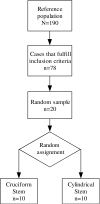Influence of the tibial stem design on bone density after cemented total knee arthroplasty: a prospective seven-year follow-up study
- PMID: 17115154
- PMCID: PMC2219935
- DOI: 10.1007/s00264-006-0280-y
Influence of the tibial stem design on bone density after cemented total knee arthroplasty: a prospective seven-year follow-up study
Abstract
We prospectively measured the changes in bone mineral density (BMD) in the proximal tibia of 20 total knee arthroplasties, ten with cruciform stems and ten with cylindrical stems. The measurements were made one, four and seven years after surgery. We observed a uniform density decrease in three regions of interest from one to seven years of follow-up. Cylindrical stems showed an asymmetrical density decrease between the three regions of interest, with no change in the central region, a slight decrease in the lateral region, and large decrease in the medial region. Multivariate analysis with general linear model showed the stem type factor as statistically significant for medial region of interest (p = 0.006). The cylindrical stem produces heterogeneous BMD changes under the tibial platform in knee arthroplasties, and this could be a potential risk factor for asymmetrical subsidence of this component.
Nous avons de façon prospective mesuré les modifications de la densité minérale osseuse (BMD) au niveau de la partie proximale du tibia chez 20 patients ayant bénéficié d’une prothèse totale du genou, 10 avec une quille cruciforme et 10 avec une quille cylindrique. Les mesures ont été réalisées de 1.4 à 7 ans après l’intervention chirurgicale. Nous avons observé une diminution uniforme de la densité minérale osseuse dans trois zones, durant cette période de 1 à 7 ans de suivi. La quille cylindrique montre que la densité minérale osseuse diminue de façon asymétrique dans ces 3 régions sans modification au niveau de la région centrale, avec une légère diminution de la région externe (latérale) et une diminution plus importante de la région interne (médiale). Une analyse de régression multi variable montre que le type de quille est l’élément le plus significatif au niveau de la région interne (p = 0.006). La quille cylindrique étant un facteur statistiquement significatif et entraînant des modifications hétérogènes de la BMD, sous le plateau tibial. Ces modifications peuvent être un risque potentiel de migration du composant tibial.
Figures
Comment in
-
Periprosthetic tibial bone mineral density changes after total knee arthroplasty.Acta Orthop. 2016 Jun;87(3):268-73. doi: 10.3109/17453674.2016.1173982. Epub 2016 Apr 27. Acta Orthop. 2016. PMID: 27120266 Free PMC article.
References
-
- {'text': '', 'ref_index': 1, 'ids': [{'type': 'DOI', 'value': '10.1097/00003086-199811000-00012', 'is_inner': False, 'url': 'https://doi.org/10.1097/00003086-199811000-00012'}, {'type': 'PubMed', 'value': '9917670', 'is_inner': True, 'url': 'https://pubmed.ncbi.nlm.nih.gov/9917670/'}]}
- Bert JM, McShane M (1998) Is it necessary to cement the tibial stem in cemented total knee arthroplasty? Clin Orthop 356:73–78 - PubMed
-
- {'text': '', 'ref_index': 1, 'ids': [{'type': 'PubMed', 'value': '2805502', 'is_inner': True, 'url': 'https://pubmed.ncbi.nlm.nih.gov/2805502/'}]}
- Ewald FC (1989)The knee society total knee arthroplasty roentgenographic evaluation and scoring system. Clin Orthop 248:9–12 - PubMed
-
- {'text': '', 'ref_index': 1, 'ids': [{'type': 'DOI', 'value': '10.1080/17453670510045381', 'is_inner': False, 'url': 'https://doi.org/10.1080/17453670510045381'}, {'type': 'PubMed', 'value': '16470431', 'is_inner': True, 'url': 'https://pubmed.ncbi.nlm.nih.gov/16470431/'}]}
- Hernandez-Vaquero D, Garcia-Sandoval MA, Fernandez-Carreira JM, Suarez-Vazquez A, Perez-Hernandez D (2005) Measurement of bone mineral density is possible with standard radiographs: a study involving total knee replacement. Acta Orthop 76:791–795 - PubMed
-
- {'text': '', 'ref_index': 1, 'ids': [{'type': 'DOI', 'value': '10.1007/s004020050419', 'is_inner': False, 'url': 'https://doi.org/10.1007/s004020050419'}, {'type': 'PubMed', 'value': '10447632', 'is_inner': True, 'url': 'https://pubmed.ncbi.nlm.nih.gov/10447632/'}]}
- Karbowski A, Schwitalle M, Eckardt A, Heine J (1999) Periprosthetic bone remodelling after total knee arthroplasty: early assessment by dual energy X-ray absorptiometry. Arch Orthop Trauma Surg 119:324–326 - PubMed
-
- {'text': '', 'ref_index': 1, 'ids': [{'type': 'PubMed', 'value': '1959268', 'is_inner': True, 'url': 'https://pubmed.ncbi.nlm.nih.gov/1959268/'}]}
- Lee RW, Volz RG, Sheridan DC (1991) The role of fixation and bone quality on the mechanical stability of tibial knee components. Clin Orthop 273:177–183 - PubMed
Publication types
MeSH terms
LinkOut - more resources
Full Text Sources
Medical




